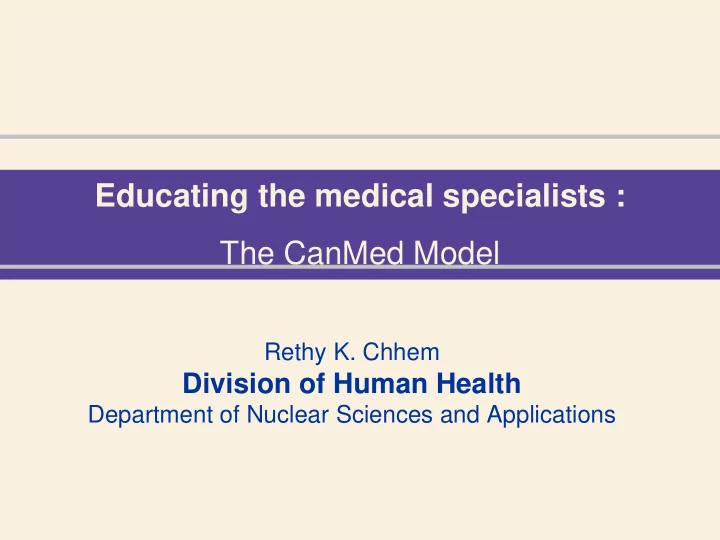

Educating the medical specialists : The CanMed Model Rethy K. Chhem Division of Human Health Department of Nuclear Sciences and Applications IAEA
What is CanMEDS? • “Canadian Medical Education Directions for Specialists.” • Framework that seeks to answer a fundamental question: - “How can we best prepare physicians to be effective in this environment and truly meet the needs of their patients?” IAEA
History of CanMEDS • When? Early 90s • Why? A need to reform medical education due to: • the explosion of medical knowledge, • access to medical information on the Internet, • an increase in disruptive technologies, etc. IAEA
CanMEDS competencies The Royal College of Physicians and Surgeons of Canada selected: 7 general competencies for specialists IAEA
Competencies? • “Complex set of behaviors built on the components of knowledge, skills, attitudes, and competence as personal ability.” • S hift from “structure- and process-based” curriculum to competency-based education and outcomes evaluation. Caraccio et al, 2002 IAEA
Competencies - focuses on performance of the end-product or goal-state of instruction - reflects expectations that are external to the immediate instructional programme - expressible in terms of measurable behaviour - uses a standard for judging competence that is not dependent upon the performance of other learners - informs learners about what is expected of them Albanese et al, 2008 IAEA
Outcome-based education • Development of clearly defined and published learning outcomes that must be achieved before the end of the course; • Design of a curriculum and learning strategies to ensure the achievement of the learning outcome; • Assessment process that matched to the learning outcomes; • Provision of remediation and enrichment for students as appropriate. Harden, 2002 IAEA
What is CanMEDS? • Framework structure: 7 thematic groups of competencies • “Medical expert” is the central integrative role IAEA
1. Medical Expert The physician should be able to: • Function effectively as consultants, integrating all of the CanMEDS Roles to provide optimal, ethical and patient- centered medical care; • Establish and maintain clinical knowledge, skills and attitudes appropriate to his/her practice; • Perform a complete and appropriate assessment of a patient; • Use preventive and therapeutic interventions effectively; • Demonstrate proficient and appropriate use, both diagnostic and therapeutic skills; • Seek appropriate consultation from other health professionals, recognizing the limits of his/her expertise. IAEA
2. Communicator The physician should be able to: (In relationships with patients and families, colleagues and other health professionals) • Develop rapport, trust and ethical therapeutic; • Accurately elicit and synthesize relevant information; • Accurately convey relevant information and explanations; • Develop a common understanding on issues, problems and plans. IAEA
3. Collaborator The physician should be able to: • Participate effectively and appropriately on an interprofessional healthcare team; • Effectively work with other health professionals to prevent, negotiate, and resolve interprofessional conflict. IAEA
4. Manager The physician should be able to: • Contribute to the effectiveness of healthcare organizations. Allocate finite healthcare resources appropriately; • Manage his/her practice and career effectively; • Serve in administration and leadership roles, as appropriate. IAEA
5. Health Advocate The physician should be able to: • Respond to individual patient and communities health needs; • Identify the determinants of health of the populations; • Promote the health of individual patients, communities and populations. IAEA
6. Scholar The physician should be able to: • Contribute to the creation, dissemination, application, and translation of new medical knowledge; • Practice evidence-based medicine; • Facilitate the learning of patients, families, students, residents, other health professionals, the public. IAEA
7. Professional The physician should be able to: • Demonstrate a commitment to her patients, profession, and society through ethical practice; participation in profession-led regulation; • Demonstrate a commitment to physician health and sustainable practice. IAEA
How to evaluate competences? • Relevant and optimal tools for a valid and accurate assessment • Reliability: “a way to deliver consistent results in the same situation time after time” • Validity: “assessing intended knowledge, attitudes, skills or behaviors, that are accepted as legitimate by teachers and learners” IAEA
How to evaluate competences? • Process should be placed in “a concrete, observable learner behaviours or well- defined components of a learner’s knowledge base” • Role and use of portfolio learning for personal and professional development IAEA
Key tools for assessing the CanMEDS competencies (Bandiera et al. 2006) Medical Communi Collabo- Health Manager Scholar Profes- Expert -cator rator advocate sional 1. Written +++ + ++ ++ + ++ + tests (MCQ, SAQ) 2. Essays ++ + + +++ + + + 3. Oral exam +++ + + + * * + 4. Direct +++ +++ +++ +++ +++ +++ +++ observation and ITER 5. OSCE/SP +++ +++ +++ ++ * * + 6. Multi-source ++ +++ +++ +++ +++ ++ +++ feedback 7. Portfolio ++ ++ + +++ ++ +++ +++ 8. Simulations +++ + +++ * ++ * ++ IAEA
Challenges for Implementation Successful implementation of CanMEDS requires a strategy involving 4 main domains: 1. Standards for curriculum teaching and assessment; 2. Faculty Development for CanMEDS; 3. Research and Development Resources; 4. Outreach and Communication. IAEA
Challenges for Implementation Inter-professional cooperation Need to establish connections with related health professionals: technicians, nurses, chiropractors, physicians’ assistants, pharmacists. IAEA
Challenges for Implementation Globalization Partnerships and collaboration across the globe by openly sharing CanMEDS intellectual property worldwide IAEA
Thank you IAEA
Recommend
More recommend